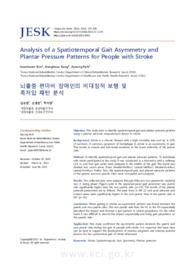

-
미리보기
서지정보
· 발행기관 : 대한인간공학회
· 수록지 정보 : 대한인간공학회지 / 42권 / 3호 / 197 ~ 208페이지
· 저자명 : 김순범, 강동헌, 박지영
초록
Objective: This study aims to identify spatiotemporal gait and plantar pressure patterns using a plantar pressure measurement device in stroke.
Background: Stroke is a chronic disease with a high mortality rate and up to 50% of survivors. A common symptom of hemiplegia in stroke is an asymmetry in gait.
This results in muscle and functional weakness in the lower extremity of the paretic side.
Method: To identify spatiotemporal gait and plantar pressure patterns, 10 individuals with stroke participated in the study. It was conducted in a laboratory with a walkway of 6 m, and four gait cycles were analyzed in the middle of the gait. The insole was divided into seven areas (Heel, Medial-Midfoot, Lateral-Midfoot, Medial-Forefoot, Lateral-Forefoot, Hallux, Toe), the spatiotemporal gait, and plantar pressure patterns of the paretic and non-paretic sides were compared and analyzed.
Results: The collected data were analyzed through Wilcoxon non-parametric statistical test. A Swing phase (%gait cycle) in the spatiotemporal gait parameter was paretic side significantly higher than the non-paretic side (p<.05). The results of the plantar pressure parameters are as follows. The peak force in MF, LF, and peak pressure and contact areas were significantly higher in the non-paretic than in the paretic side in MF (p<.05).
Conclusion: When gaiting in stroke, an asymmetric pattern was found between the paretic and non-paretic sides. The non-paretic side from the HL to the HX sequentially absorbed the impact and showed a gait pattern to obtain propulsion. On the other hand, it was difficult to absorb the impact sequentially and bring gait propulsion on the paretic side.
Application: This study confirmed the asymmetric pattern between the paretic and non-paretic side during the gait of people with stroke. It is expected that basic data can be used to support the development of exercise programs and exercise assistive devices for the symmetrical gait of stroke afterward.영어초록
Objective: This study aims to identify spatiotemporal gait and plantar pressure patterns using a plantar pressure measurement device in stroke.
Background: Stroke is a chronic disease with a high mortality rate and up to 50% of survivors. A common symptom of hemiplegia in stroke is an asymmetry in gait.
This results in muscle and functional weakness in the lower extremity of the paretic side.
Method: To identify spatiotemporal gait and plantar pressure patterns, 10 individuals with stroke participated in the study. It was conducted in a laboratory with a walkway of 6 m, and four gait cycles were analyzed in the middle of the gait. The insole was divided into seven areas (Heel, Medial-Midfoot, Lateral-Midfoot, Medial-Forefoot, Lateral-Forefoot, Hallux, Toe), the spatiotemporal gait, and plantar pressure patterns of the paretic and non-paretic sides were compared and analyzed.
Results: The collected data were analyzed through Wilcoxon non-parametric statistical test. A Swing phase (%gait cycle) in the spatiotemporal gait parameter was paretic side significantly higher than the non-paretic side (p<.05). The results of the plantar pressure parameters are as follows. The peak force in MF, LF, and peak pressure and contact areas were significantly higher in the non-paretic than in the paretic side in MF (p<.05).
Conclusion: When gaiting in stroke, an asymmetric pattern was found between the paretic and non-paretic sides. The non-paretic side from the HL to the HX sequentially absorbed the impact and showed a gait pattern to obtain propulsion. On the other hand, it was difficult to absorb the impact sequentially and bring gait propulsion on the paretic side.
Application: This study confirmed the asymmetric pattern between the paretic and non-paretic side during the gait of people with stroke. It is expected that basic data can be used to support the development of exercise programs and exercise assistive devices for the symmetrical gait of stroke afterward.참고자료
· 없음태그
-
자주묻는질문의 답변을 확인해 주세요

꼭 알아주세요
-
자료의 정보 및 내용의 진실성에 대하여 해피캠퍼스는 보증하지 않으며, 해당 정보 및 게시물 저작권과 기타 법적 책임은 자료 등록자에게 있습니다.
자료 및 게시물 내용의 불법적 이용, 무단 전재∙배포는 금지되어 있습니다.
저작권침해, 명예훼손 등 분쟁 요소 발견 시 고객센터의 저작권침해 신고센터를 이용해 주시기 바랍니다. -
해피캠퍼스는 구매자와 판매자 모두가 만족하는 서비스가 되도록 노력하고 있으며, 아래의 4가지 자료환불 조건을 꼭 확인해주시기 바랍니다.
파일오류 중복자료 저작권 없음 설명과 실제 내용 불일치 파일의 다운로드가 제대로 되지 않거나 파일형식에 맞는 프로그램으로 정상 작동하지 않는 경우 다른 자료와 70% 이상 내용이 일치하는 경우 (중복임을 확인할 수 있는 근거 필요함) 인터넷의 다른 사이트, 연구기관, 학교, 서적 등의 자료를 도용한 경우 자료의 설명과 실제 자료의 내용이 일치하지 않는 경우
“대한인간공학회지”의 다른 논문도 확인해 보세요!
-
지속가능성을 위한 마스크 재활용 플랫폼 제안: 서비스 디자인 방법론을 중심으로 9 페이지
Objective: This study aims to propose a 'discarded face mask collection and utilization platform' based on service design methodology to continuously address the environmental pollution caused by disc.. -
콜센터 상담사를 위한 악성전화 자동차단 시스템개발 11 페이지
Objective: The purpose of this study is to build a system base that automatically blocks malicious calls such as customer's verbal abuse by utilizing voice recognition technology before occurrence. Ba.. -
액션캠 사용 여부가 작업절차 위반에 미치는 호손 효과에 관한 연구: PSM 사업장을 중심으로 10 페이지
Objective: The purpose of this study was to experimentally determine whether taking a working image acts as a Hawthorne effect to reduce human errors. Background: Most of the accidents are caused by h..
문서 초안을 생성해주는 EasyAI

